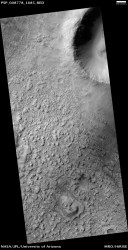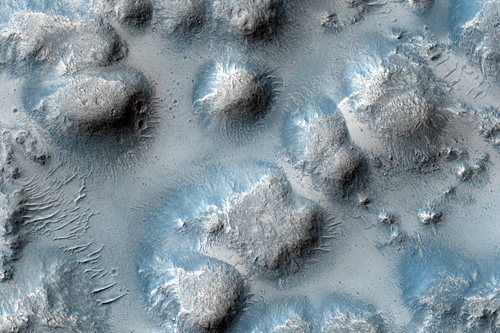[/caption]
The High Resolution Imaging Science Experiment (HiRISE) continues to churn up stunning images as NASA’s Mars Reconnaissance Orbiter passes over the Martian surface. However, today’s example probably creates more questions than answers. Close to the Mars equator, south of Elysium Planitia, exists a crater and inside are some strange mounds that have so far eluded formal explanation. There are a few possibilities how these mounds may have formed and there may also be some examples on Earth too…
These features resemble mesas being stripped by Martian winds, or a build-up of sand/sediment dropped after a sand storm. Actually, these “mystery” features are not formed by sand and may not have been carved out by the wind. This image was commissioned by the HiRISE team to investigate a previous Mars Orbital Camera (MOC, on the Mars Global Surveyor) image of the region showed an ancient filled-in crater with some strange undulations in the bottom. Using the full 25 cm/pixel resolving power of HiRISE, these features can be seen in great detail.

The largest mounds appear to be around 200 meters wide and vary in shape. Between the mounds appear to be wind-blown sand features, but scientists cannot explain the formation of the mounds at present. Attention is being paid to the rough surface texture of the mounds which suggests they may be outcrops of tough bedrock where loose sand or sedimentary rock has been eroded away, leaving the mounds behind. But how did this erosion occur and why is the bedrock so hardy?
The mounds could be ancient lava flows, fluvial sediment (indicating a plentiful supply of water in the past) or impact ejecta (i.e. hot material kicked into the old crater after another impact). Any one of these factors may have produced these hardened features. The strange thing is that there is a huge plain of these mounds, they aren’t isolated features. To be able to determine the origin of these mounds, further analysis needs to be carried out. The Compact Reconnaissance Imaging Spectrometer for Mars (CRISM) on board the Mars Reconnaissance Orbiter will now be used to derive the mineral content of the region so a better understanding can be attained. But until then, these mounds will remain a true Martian mystery…
Source: HiRISE


Ancient Martian Burial Grounds!
It would be nice to see the true colors.
Looks like stromatolites or coral to me.
The direction of wind doesn’t seem right. With this picture, it looks like the wind is coming straigh down.
Pretty interesting though and a pretty picture, too.
Is it possible that these are artifacts from the geological uplifting of Elysium Planitia? If you had a region of subsurface ice covered by volcanic ash and then pushed it up from beneath, wouldn’t you get similar patterns as the exposed areas of ice melted or sublimated? The ice that was still covered would remain to give you these mesas. If the process took place over a long period of time, I imagine it might even have the appearance of eroded terrain. Maybe the ice isn’t even a requirement. I’m just guessing.
I agree with Acy. They must giant martian stromatolites.
Its looks to me like these ripples are more influenced by seismic distrurbances and less by wind–you will note that they seem to concentrate at the bottom of the craters in the same pattern as above and around the craters.–wind might swirl or funnel down a crater possible producing a different shape;
yes the anlogy to coral is very interesting because I have similar sand ripples off southern california at the bottom of the ocean when I scuba dive, and we don’t have much wind at the bottom of the ocean but alot of seismic turbulence.
or it could be a combination of both, mars is quite wind turbulent, but what do we really know about underneath?
Does anyone have a reference to explain what the colors mean? I suppose they’re not the color that a human would perceive, but whatever spectral information is contained was picked for a good reason – I hope. I’d just like to find out.
Thanks!
these are definitely ancient graves left over from an ancient civilization
@TD: there’s a FAQ in the HiRISE pages at http://hirise.lpl.arizona.edu/faq/ which explains pretty much all the most common questions regarding these images.
It only misses (or maybe it was I who missed) mentioning the fact that HiRISE images show near infrared data on the red channel, red data on the green channel and blue-green data on the blue channel and maximizes contrast in each of the channels individually.
Jorge,
thanks – so from reading it, the explanation is that is highlights differences between materials. It’s interesting in many “fossae” images that the material within the fossae is very different than the surface material. It’s also interesting that “fossae” means “ditch or canal” in Latin. I wonder why U of A didn’t have the spine to call them canals?
I’m sure that infamous crank Richard Hoagland is at home right now drawing lines and angles all over that photo in MS-Paint.
It also resembles what happens to the human skin around the corners of our eyes; as we age it wrinkles quickly as skin is drier and shrinking and not as robust or pink as it once in our youth when more blood and moisture flowed thru those cells of the skin…a doctor could probbaly explain this better.
so my gues is the subsurface is not nearly as dense near the surface and its collpasing back in on itself as the water or ice underneath dry’s out or evaloprates too quickly; as it was mentioned earlier “geological uplifting of Elysium Planitia” is also a possibility…
also possiblly seismic disturbance could really be a an excellent trigger to start the wrinkle ball rolling, especially its drying out too qiuckly underneath.
afterall we are seeing this at the MARTIAN EQUATOR and Mar’s season are very similar to Earth’s since our aixis of tilts are very close….and its also July right now on Mars.
I’d like to see these pictures in February when its winter.
should one expect to see such things near Equators where things dry out more unevenly and are more potentially sesismic especially during the summer months?
Looks like an island chain to me…
It looks to be a heated bubbling uplifting of the surface material from the center of the crater created on impact. Far, far too smooth and differently shaped to be stromatolites. Doubtful its wind creations either.